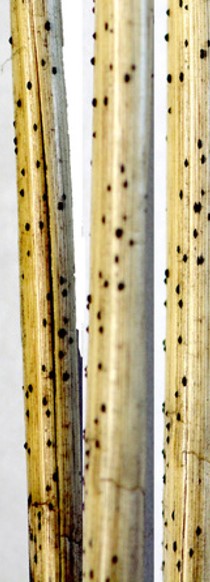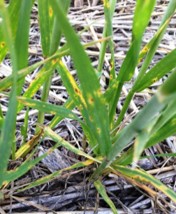Pathogen Facts
- Tan spot, also known as yellow leaf spot, is caused by the fungal pathogen Pyrenophora tritici-repentis.
- This disease is polycyclic, meaning multiple infections can happen throughout the growing season.

Wheat leaf with tan spot lesions during different stages of maturity. Photo courtesy of Sam Tragesser, Senior Research Associate
Symptoms and Signs
- Initial symptoms are tan necrotic spots surrounded by a yellow halo.
- As lesions expand they take on a more angular, diamond shape, and typically have a darker center.
- Lesions coalesce and form large, tan blotchy areas of necrosis.
- From tillering to ripening, a red/dirty smudge can be seen on ripening kernels.
- On straw stems, dark colored overwintering structures can be visible in the fall.

Wheat stems with dark colored overwintering structures. Photo courtesy of Emmanuel Byamukama, South Dakota State University, Bugwood.org.
Conditions Favoring Disease
- Tan spot is favored by wet, windy weather that is conducive for spore development and distribution.
- Because this disease is polycyclic, infection can occur at any time during the growing season.
- This disease overwinters on crop residue and grassy hosts.
- When leaf wetness reaches or exceeds 24 hours, the disease develops and spreads rapidly
Management Considerations
- Varieties with moderate levels of resistance are available.
- Pyrenophora tritici-repentis overwinters in crop debris, so production practices such as tillage and crop rotation, that reduce the amount of crop residue on the surface, will decrease the amount of primary inoculum.
- Foliar fungicides can be applied to mitigate the impacts of tan spot.
- Farmers must consider the variety susceptibility, weather forecasts, cost of the application, and the market value of their grain before determining if fungicides will be an economical solution.


Wheat leaf with irregular shaped tan spot lesions (right) and wheat plants in field displaying typical tan spot symptoms (left). Photo courtesy of Mourad Louadfel, Homemade, Bugwood.org and Emmanuel Byamukama, South Dakota State University, Bugwood.org, respectively.
References
Crop Protection Network. 2019. Tan Spot of Wheat. Retrieved from Crop Protection Network: https://cropprotectionnetwork.org/resources/articles/diseases/tan-spot-of-wheat
Wegulo, S. N. 2011. Tan spot of cereals. Retrieved from American Phytopathological Society: https://www.apsnet.org/edcenter/disandpath/fungalasco/pdlessons/
Pages/TanSpot.aspx
Wegulo, S. N., Klein, R. N., & Harveson, R. M. 2012. NebGuide. Retrieved from Tan Spot of Wheat: http://extensionpublications.unl.edu/assets/pdf/g429.pdf
Author: Madeline Henrickson
The foregoing is provided for informational use only. Please contact your Pioneer sales professional for information and suggestions specific to your operation. Product performance is variable and depends on many factors such as moisture and heat stress, soil type, management practices and environmental stress as well as disease and pest pressures. Individual results may vary.
Vol. 12 No. 13 May 2020









